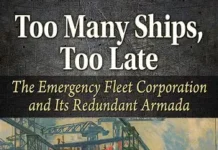
Australia’s Naval Alliances. Lessons in History. By John Seymour. Cambridge Scholars Publishing 2025.
Additional Review by Tim Coyle
John Mortimer recently reviewed Australia’s Naval Alliances in the Australian Naval Institute Newsletter. I don’t propose to repeat John’s detailed summary of the book, but support his conclusions drawn largely from the author, John Seymour’s final chapter: AUKUS 2021-2024. The Lessons in History are largely based on the parallels in the strategic maritime elements from the early 20th century to today; arguably no other country can claim these consistent parallels which are:
- Australia’s strategic geography.
- Australia faced a perceived emergent maritime threat from Imperial Japan from the early 20th century to the 1940s; in the 2020s it is the threat from the People’s Republic of China’s maritime forces – the People’s Liberation Army – Navy (PLAN), the China Coast Guard and the People’s Armed Police Maritime Militia.
- Australia looked to the Royal Navy as the Empire’s overall maritime protector in which the Royal Australian Navy was a component. After the Australian Prime Minister Curtin’s 27 December 1941 ‘Look to America’ speech the maritime overlord became the US Navy.
- For 120 years – and into the future – It has been generally accepted that Australia alone cannot defend itself and requires alliance protection (although many contemporary commentators dispute this).
An objective appreciation of the ‘Empire’ era (1901 to 1941), examined in Australian Naval Alliances, discusses the tenuous arguments advanced by the British and Australian Governments regarding how the Empire would address maritime security in what is now termed the Indo-Pacific. Britain progressively lost world-wide command of the sea as threats developed in the 1930s and financial constraints limited naval armaments. Australia, alarmed by these diminishing capabilities, consistently warned Britain of Australia’s defence limitations. The putative compromise of a ‘Main Fleet to Singapore’, where a fortified naval base was to be established, proved to be an abortive paper solution with the sinking of HM Ships Prince of Wales and Repulse and the fall of Singapore.
The RAN Fleet Unit – born out of early 20th century Australian badgering of the British Government and, led by the battle Cruiser HMAS Australia arriving in 1913, was a powerful naval force in which Australia had high hopes. For the first few months of the war, the RAN formed a strategic asset in the Pacific. Under Admiralty direction, the Australian Naval and Miitary Force secured German colonial territories in New Guinea, Samoa and New Britain. Consequently, HMAS Australia was not tasked to hunt down the German East Asia squadron which fled from its base in Tsingtao, China. Comprising four unarmoured and two armoured cruisers – SMSs Scharnhorst and Gneisenau – the squadron sought to cause as much disruption as possible before attempting to reach Germany.
In these formative months the RAN fulfilled its purpose of exerting maritime power in the Pacific region. Although it did not vanquish the East Asia squadron in battle that force’s fate was sealed, despite its victory at the Battle of Coronel; the squadron’s subsequent destruction by the Royal Navy was inevitable.
The other demonstration of the RAN’s regional superiority was the Sydney-Emden action thereby clearing the Asia-Pacific of German sea power. These actions in 1914 were the only occasions in which the RAN exerted stand-alone regional maritime superiority.
The RAN was subsequently subsumed into the Royal Navy with its destroyer force undertaking fine work in the Mediterranean while the flagship Australia took its place as a minor player in the Grand Fleet (it missed the Battle of Jutland). The battle cruiser was considered obsolete after the war.
The postwar invitation to former Grand Fleet commander and First Sea Lord, Admiral Sir John Jellicoe, to review Australian maritime defences led, on the one hand, to exuberant outpourings of adulation among the general population, fostered largely by the popular press, of a scale that approached the hysteria of a royal tour. The recommendations in his report were more soberly assessed by knowledgeable commentators of the day as primarily impractical given the financial constraints under which the Royal Navy was suffering postwar and the impossible materiel acquisition demands for an upgraded RAN. Much subjective analysis bordered on ‘wishful thinking’ subsequently demonstrated by the Singapore and the Main Fleet debacle.
The ‘Look to America’ extended from December 1941 to the present day. The -United States saw Australia as a strategic asset for training, basing and logistic support to the South-West Pacific operations under General Douglas MacArthur; it was in the US national interest to invest in Australia.. The RAN served gallantly as an integrated asset with the US Navy and US submarines were based at Fremantle and Brisbane. The submarine force was a major contributor to the destruction of the Japanese merchant marine and the IJN (after the scandal of US torpedo deficiencies were resolved in 1943).
The ’hallowed’ ANZUS treaty of 1951 is an agreement for the three parties to ‘consult’ in the event of a perceived threat to any of them. It comprises less than 1000 words. Australian Prime Minister John Howard leaped to invoke the treaty over the 9/11 attack (he was present at the Pentagon on that day).
So, the parallels in history which have faced Australia since 1901 are:
- Its geography – huge and difficult to defend.
- A perceived threat from a potential regional hegemon – Imperial Japan 1901 – 1945 and the contemporary People’s Republic of China (identified as such in the 2023 Defence Strategic Review).
- Australia agitated for British naval protection which was objectively infeasible; Australia has sought similar assurances from the US since 1951 and, according to various government ministers and defence officials, the ADF is now ‘integrated’ with US forces, and they continue to advocate the critical importance of the US to Australia’s defence.
- The Singapore ‘Main Fleet Base’ never eventuated. As nuclear attack submarines (SSN) are now the 21stcentury ‘capital ships’ their base will be situated at HMAS Stirling from 2027 with the establishment of Submarine Rotational Force – West, comprising US and British SSNs, with RAN SSNs joining them from 2032.
- A significant debating point in the prewar Empire negotiations was the RAN’s integration into a proposed British Eastern Fleet. In the 2020s and beyond the critical question is to what extent the ADF, and specifically Navy, will be subject to US direction against a worst-case Taiwan contingency. Defence Minister Marles has assured the Australian public that the RAN SSNs will be deployed in defence of Australian Sea Lines of Communication and will always be under Australian command. But will there be a presumption that our SSNs would be expected to form part of the US subsurface order-of-battle as a condition for the transfer of the three to five Viginia-class boats? Marles’ assurance can have many interpretations of what constitutes SLOC protection and Australian command. Because submarine operations are highly classified, the Australian public won’t know what our submarines are doing (as is the case today),
Apart from the US alliance Australia has strong defence relationships with New Zealand, Japan and the Philippines and have been recently joined by formal agreements with PNG and Indonesia. These relationships add to the long-term associations Australia enjoys with Singapore, Malaysia, South Korea and India (the ‘Quad’ is yet to demonstrate any substance). After the diplomatic shock of 2021, when the Solomon Islands veered towards the PRC, Australia has robustly redirected its focus to the South Pacific nations which had languished largely due to Australian complacency.
These relationships are very valuable and must be encouraged and maintained through constructive participation in organisations such as APEC and ASEAN while maximising ADF defence relationships through Navy International Engagement activities including the annual Indo Pacific Endeavour program and formal exercises.
The RAN was a strategic maritime asset for three months in 1914, a frustrated pawn in the 20-year interwar hiatus with our putative Empire ‘protector’ and an unrequited suitor in the US alliance since 1951. This last will be contingent on the transfer of the ‘three to five’ Virginia-class SSNs (‘on time and on budget’) – and the delivery of the vasty upgraded shipyard and support capabilities to build and maintain the staggeringly ambitious AUKUS program.
The way ahead is indeterminate and challenging. In Australia’s Naval Alliances, John Seymour has superbly articulated Lessons from History. In history there are always parallels to the present and future for those who seek them out.



